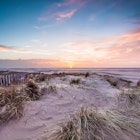
Jun 22, 2024 • 4 min read
Wales, though one of the four constituent countries of the UK, has its own rhythm, its own culture and its own reasons to be visited. It's a land of legends and the legendary (dragons feature in its ancient stories and King Arthur was first written about in Welsh). A place made up of stunning landscapes like Snowdonia, adorned with majestic castles like Caernarfon, and fringed by magnificent coastline like Pembrokeshire.
Despite its relatively small size, for a first time visitor it’s helpful to have some pointers. Here’s our action plan for making the most of your foray to Cymru (pronounced kum-ree) as locals like to call it.

Population 3.1m
Annual visitors 10m (plus 100m day visitors)
Daily budget £80-£150, depending on location and standard of accommodation
Number of sheep Over 10m
Areas of Outstanding Natural Beauty 5
National parks 3, protecting 20% of the country
Tallest mountain Snowdon (1085m)
Letters in the Welsh alphabet 28
Longest place name Llanfairpwllgwyngyllgogerychwyrndrobwllllantysiliogogogoch (58 letters)
Wales can be roughly divided into three sections: North Wales, Mid Wales and South Wales.
North Wales brings in plenty of thrill-seekers and nature lovers. Snowdonia National Park alone attracts over 350,000 people a year to its 90 peaks, the main one being Snowdon itself (reachable by foot or on the mountainside train). Aside from hiking, walking and birdwatching, other opportunities for getting active include jumping on springy cargo nets in an underground cavern at Bounce Below, whizzing down the world's fastest zip wire over the Penrhyn Quarry with Zip World and wakeboarding on the pristine waters of the LlÅ·n Peninsula.
To the east is Pontcysyllte Aqueduct and Canal, an 18-arch aqueduct hailed as a feat of 19th-century engineering, and Offa's Dyke Path, a national hiking trail, named after an Anglo-Saxon king, that follows the England/Wales border. Anglesey, the island in Wales' far northwest, teems with wildlife and is barely touched by humans. Explore it from Beaumaris, which has great access to the epic Menai Strait, the guillemot-housing cliffs of Holyhead and the historic Anglesey lighthouse.

The county of Ceredigion has lots of cute towns, hilly greenery and coastal attributes, with its largest town, Aberystwyth, a popular holiday resort. It has a mile-long promenade dating back to Victorian times, the oldest pier in Wales, and the largest Camera Obscura in the world, up on Constitution Hill.
Brecon Beacons National Park is Mid Wales' most famous feature, with rugged uplands, open valleys, winding rivers and superbly scenic drives. Pen-Y-Fan is its best-known peak, with the Black Mountains and the glacial Llyn y Fan Fach and Llyn y Fan Fawr lakes also winning people's hearts. The Dark Sky Reserve here gives keen stargazers the chance to see clear night skies (some B&Bs in the area even come with telescopes), while Sgwd-yr-Eira waterfall provides fairytale-like escapism.

With the Irish Sea and Bristol Channel lapping at its edge, this region is a haven for water sports, coastal walks, fresh seafood and unbelievable scenery. Pembrokeshire is the UK's only coastal National Park where, along 186 miles of coastline, you’ll find over 50 beaches, from tiny coves to expansive stretches of sand, and there’s a high chance of seeing puffins, seals, porpoises and dolphins, especially on a specialist boat tour.
St Davids, the UK's smallest city, is quaint, friendly and steeped in religious importance. It was once the home of the patron saint of Wales, hence its name, and the tucked-away cathedral is a place of Christian pilgrimage. Nearby in Abereiddy the Blue Lagoon is an old slate quarry, now filled with cyan-coloured sea water into which daredevils jump from the surrounding cliffs. There's also Whitesands Bay where surfers traverse tall waves, and Tenby, a picturesque town with beaches akin to those in the Mediterranean and a charming harbour beside pastel-coloured houses.
East of Pembrokeshire is Swansea Bay, the highlight of which is the Gower Peninsula. It was the UK's first Area of Outstanding Natural Beauty and deservedly so, with marshes, dunes, heathland, beaches, woodlands and rocky shores. Catching the sun set over The Mumbles or Worms Head at Rhossili Bay is an unforgettable experience.
With capital city Cardiff at its heart and the valleys surrounding it, the south east of the country is rich in heritage, culture and enviable countryside. Cardiff is a very compact city that can be navigated with ease by foot, bus or train. The city centre holds traces of the past (Cardiff Castle, the Victorian arcades) alongside the new, with a highlight for sports fans being the Principality Stadium, sitting on the River Taff and home to international sports matches and touring global superstars.
South east of Cardiff is the rural Vale of Glamorgan, which has award-winning beaches along its Heritage Coast, nods to Welsh mining history, castles and even vineyards.

Welsh weather is unpredictable, with a good chance of rain, so pack layers, an umbrella and a waterproof jacket. It tends to be warm from April to September (anything from 15°C to 28°C) and significantly colder in winter (averaging 6°C, with snow uncommon except in the mountains).
Aside from high-end bars and restaurants, where smarter attire is the norm, Wales is a casual country that isn't fussy about how smartly people dress. Beaches, mountains and countryside are about adventure and relaxation, so dress practically and comfortably.
Welsh food includes a few specialities well worth seeking out. Along with fresh fish and seafood, Wales’ coast also serves up laverbread (cooked seaweed, often served at breakfast). Vegetarians can tuck into Glamorgan sausages (made with cheese and leek and no meat) with a clear conscience, though will need to stay away from cawl (a broth of lamb, potato, leek and root vegetables) and faggots (herby minced offal meatballs). As for sweet treats, try Welsh cakes (flat, spiced currant cakes cooked on a bakestone) and bara brith (a dark fruity tea loaf served sliced and buttered).

Wales as a whole is a very tolerant and safe place. Cardiff and Swansea can get very busy on sports match days, so pickpocketing and alcohol-related incidents are more likely then, while if you’re out in the country and planning some outdoor activities, always check the weather to avoid getting caught unprepared.
Tipping There are no expectations to leave a tip here. If you're happy with the service, tip 10% of the bill if you wish. Sometimes Service Charge is added automatically, so check before you leave a tip. It's unnecessary to tip at bars, pubs or anywhere you don't buy food.
Manners Please and thank you go a long way here. Also, when you get off a bus say 'cheers' to the driver.
Chatter Welsh people are known for being very talkative and rather loud, so don't be alarmed if the person next to you in the queue breaks into small talk.
Cymraeg (Welsh) Wales is a bilingual country. In major cities you'll mainly hear people speaking English, but the more rural you go, the higher the chance of overhearing the melodic home language. It's compulsory for school children to learn Welsh, and you'll notice Welsh words abound on road signs, menus and in shops. Learn a word or two ('thank you' is 'diolch', pronounced dee-olkh) but don't worry, everyone here can speak English, even if Welsh is their first language.
Patriotism Welsh people are extremely patriotic – don’t be surprised if a group of middle-aged men burst into a Welsh hymn on public transport or if you see Welsh symbols like daffodils decorating buildings. They are also generally happy to engage in conversation and tell you how great their country is.

The main airport in Wales is Cardiff International Airport, which has regular flights to and from locations around the globe. You can also fly to Bristol Airport in England or one of the London airports then take a bus or train into Wales.
By road, the fastest options are the M4, M5, M6, M48 and M56. If you come into Wales via the Severn Bridge, you will have to pay the toll.
There are rail routes to South Wales (Newport and Cardiff) from London Paddington, Reading, Bath, Bristol and a couple of other stations. Change at Cardiff to go to Swansea, Carmarthenshire and Pembrokeshire. Trains from London Euston, Manchester, Birmingham, Shrewsbury and Crewe go direct to various places in North Wales.
Getting around Wales is best done by car as some areas are remote and far from public transport. As well as the motorways, there are three arterial routes known as The Wales Way. The Coastal Way passes down the west coast, the Cambrian Way crosses vertically down the middle of the country and the North Wales Way crosses the north of the country. Cars drive on the left-hand side of the road and distance is measured in miles.
Without a car, you can get by with public transport to the majority of places, or for very remote destinations there are taxis.
With energy and time, you can walk the entire length of the country’s coast thanks to the Wales Coastal Path, a well-marked and maintained network of routes to travel on foot or by bike.


Jun 22, 2024 • 4 min read




Aug 10, 2023 • 6 min read

Aug 15, 2022 • 6 min read

Jun 30, 2022 • 9 min read

